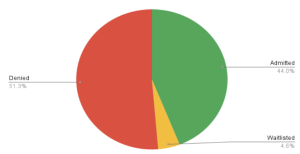Increasing numbers of sea pickles may serve as a warning
February 11, 2019
In 2017, fishermen, researchers and others enjoying the waters of the Pacific Coast noticed unprecedented numbers of pyrosomes, also called sea pickles. Two years ago, researchers were able to harvest nearly 60,000 pyrosomes with just one pull of their research net.
As Craig Welch reports for National Geographic, the appearance of the sea pickles has led to fears over massive ocean “dead zones” and worries that the pyrosomes are merely a harbinger of what’s to come.
The name pyrosomes literally means “fire bodies”, and was aptly given, as the organisms have a blue glow. In general, they resemble a “glowing sea pickle” in the water.
Many are around the size of a cucumber, though they can reach up to two feet, and their bodies are covered with miniature bumps.
The National Oceanic and Atmospheric Administration (NOAA) explains that each pyrosome is actually a collection of small multicellular organisms called zoids that work together to flush plankton, their food source, towards the mucous membranes they use to eat.
The gelatinous creatures are typically found in warmer tropical waters, but scientists suspect that global warming has led them to appear farther and farther north.
The pyrosomes have evidently been able to thrive in the oceans of Oregon and Alaska. In the spring of 2017, they were so abundant off of the coast of Oregon that some fishermen simply gave up because their nets were being overwhelmed by pyrosomes.
Craig Welch, writing for National Geographic, quotes biologist Lauren Weitkamp, saying, “For something that’s never been here before, the densities are just mind-boggling.”
Scientists were concerned that the massive numbers of pyrosomes may consume so much plankton that they would outcompete most other organisms.
Warren Cornwall reports for Science Magazine that the swarms of pyrosomes can consume up to 2 percent of the surface-level plankton, a number far lower that the original fear of 50 percent.
In 2018, scientists from the University of Oregon studied the arrival and survival of pyrosomes in the Pacific Northwest. Science Daily contacted the study authors and learned that El Nino conditions in 2016 most likely transported the pyrosomes from the coast of southern California, where they’d been seen previously, to the waters of Oregon, where they disrupted the fishing industry. The researchers are concerned that pyrosomes can consume large amounts of plankton in the surface-level waters and then die and sink, dragging precious carbon sources to deeper layers of the ocean and altering ocean ecology.
Research from the 2018 team uncovered that pyrosomes can thrive in the nutrient-poor surface waters that have been noticed along the Pacific Coast. This adaptability has allowed them to survive far from their normal tropical habitat.
Surface warming of the ocean waters prevents the less dense surface layers from mixing with the colder and more dense sub-surface waters. This prevents the valuable nutrients found in the deeper waters from being made available to organisms living near the surface of the ocean. Not all organisms can tolerate these conditions, but the pyrosomes have used these conditions to their advantage to multiply their populations by thousands.
Both the life and death of these pyrosome populations is concerning to ecologists. According to National Geographic, massive die-offs of pyrosomes will require large volumes of oxygen to decompose the pyrosome, potentially depleting the oxygen levels of the water and killing off other ocean dwellers.
In July 2018, researcher Kim Bernard reported to Science that she could easily catch buckets of pyrosomes, but as the seasons shifted they essentially disappeared. The question becomes what kind of showing the pyrosomes will make this year and how their impacts on nutrient and oxygen levels in the ocean will change the waters that we all depend on.



